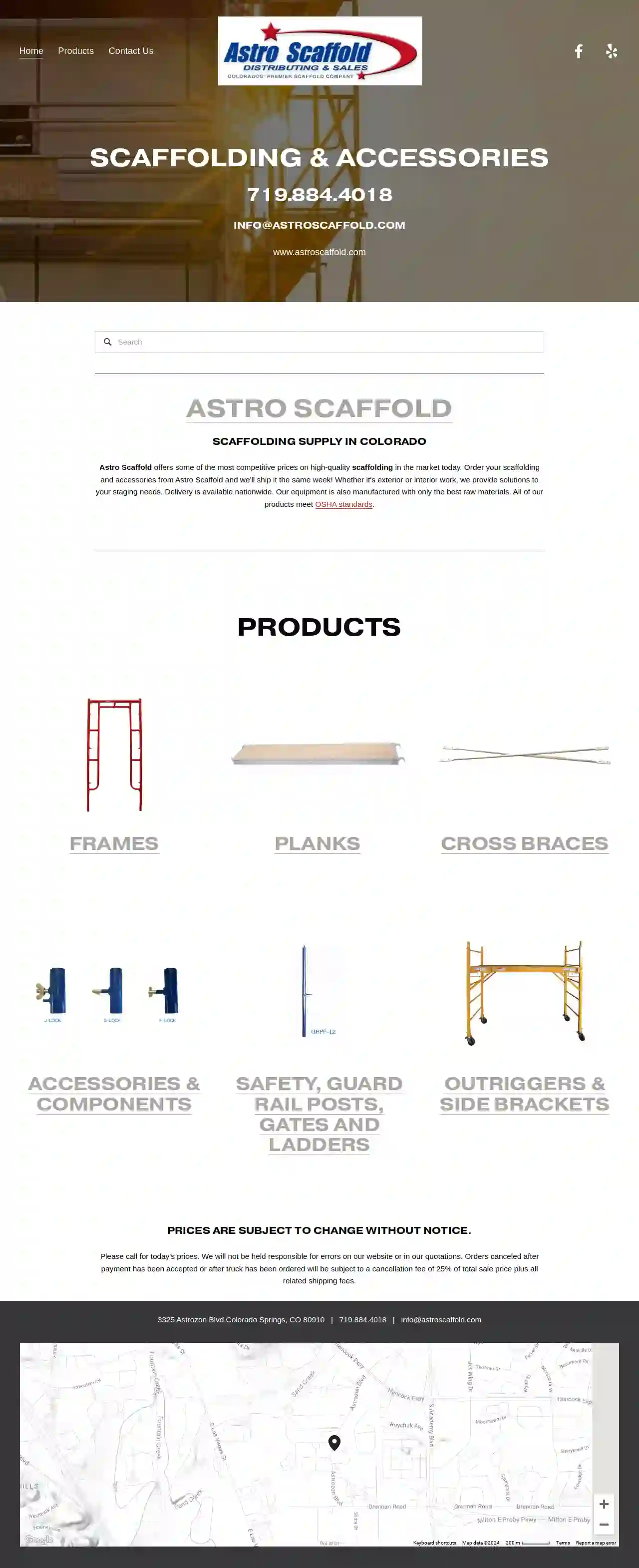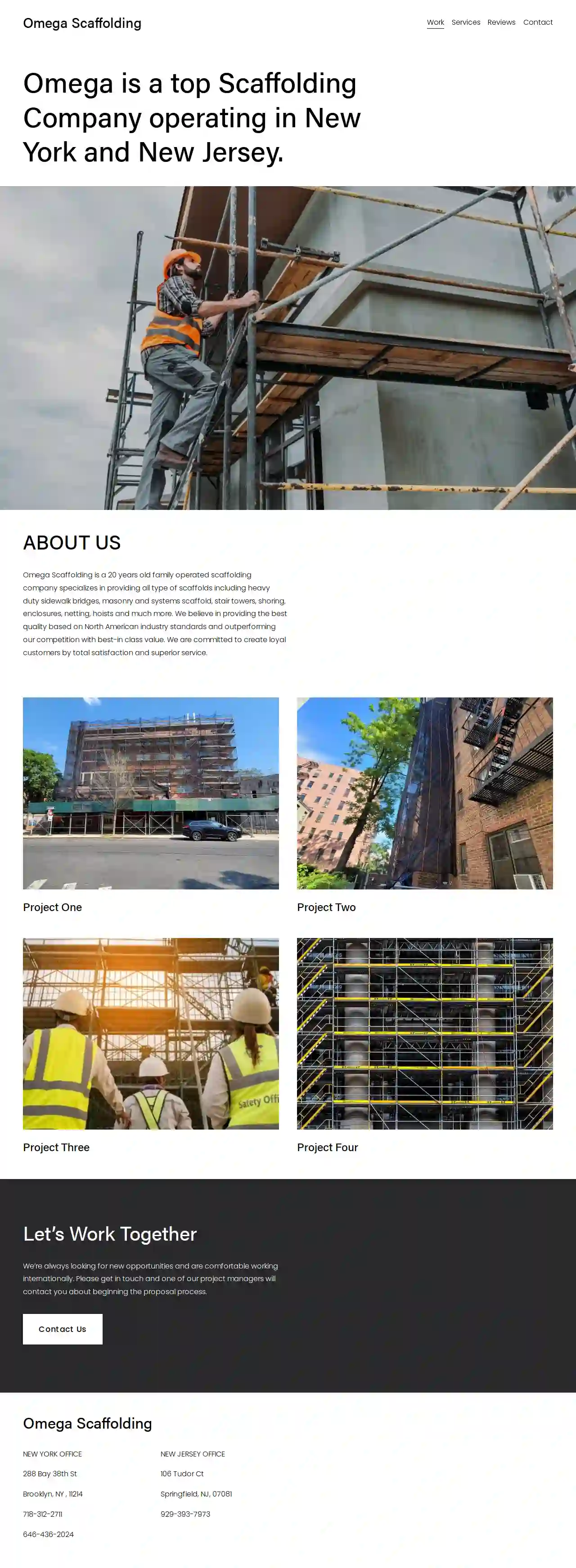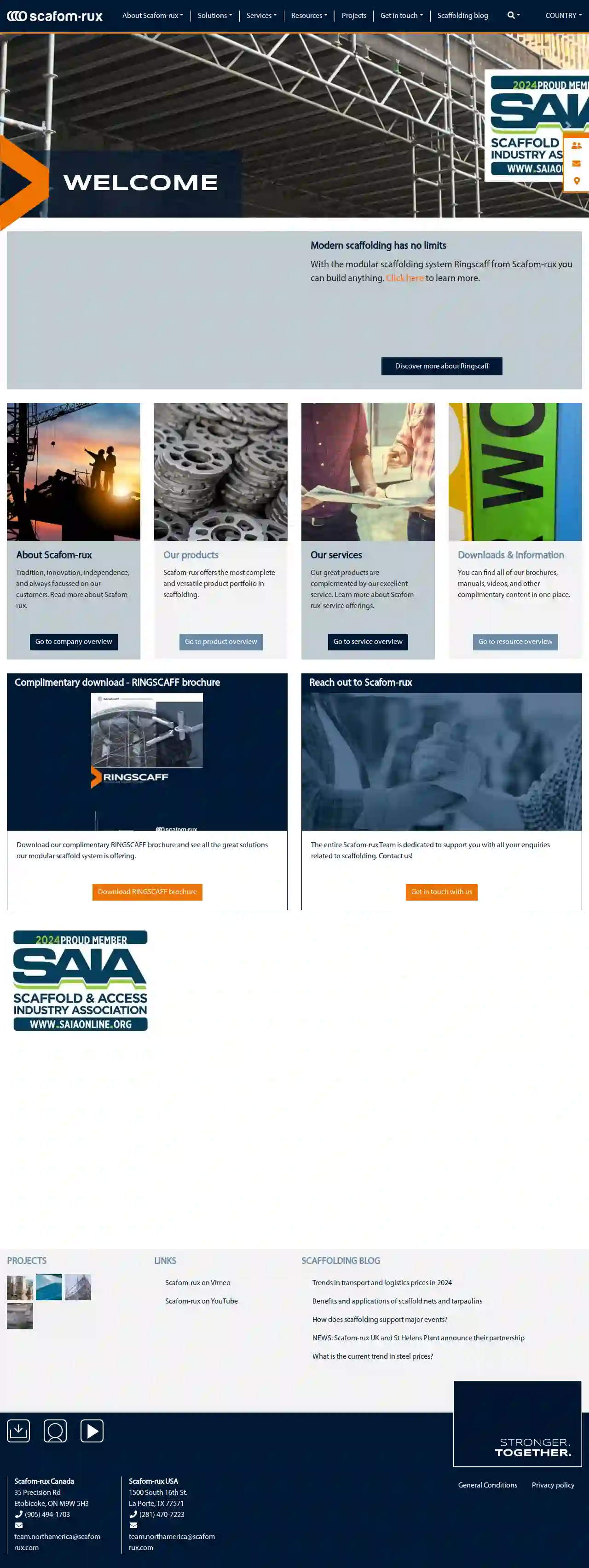Scaffolding Companies Watauga
Top 10 Scaffolding Contractors in Watauga
Get multiple Scaffolding Specialists quotes for your project today! Compare profiles, reviews, accreditations, portfolio, etc... and choose the best deal.

Astro Scaffold Distributing and Sales
4.85 reviews3325 Astrozon Blvd, Colorado Springs, 80910, USAstro Scaffold is a leading scaffolding supply company in Colorado, offering high-quality scaffolding and accessories at competitive prices. Our products meet OSHA standards and are manufactured with the best raw materials. We provide solutions for both exterior and interior work, with delivery available nationwide. Our scaffolding supply includes frames, planks, cross braces, accessories, and components, as well as safety equipment like guard rail posts, gates, and ladders. We also offer outriggers and side brackets to ensure safe and secure scaffolding. At Astro Scaffold, we pride ourselves on our excellent customer service and fast shipping. We'll ship your scaffolding and accessories the same week you order them. Please note that prices are subject to change without notice, and we recommend calling for today's prices.
- Services
- Why Us?
- Accreditations
- Gallery
Get Quote
Austin Scaffolding
2.33 reviews520 Tradesman Park Drive, Hutto, 78634, USAustin Scaffolding is a full-service scaffold company that has been providing safe and innovative access solutions to customers in Austin, Texas, and surrounding areas since 2001. Our team of skilled professionals erects and dismantles scaffolds, shoring, and canopies to OSHA and industry standards, meeting the specific access requirements of each project. We offer a personalized approach to solving access problems, ensuring that customers get the right scaffold for their project at the right price. Our services include commercial supported scaffold installation, industrial supported scaffold installation, suspended scaffold installation, protection canopies, frame and brace scaffold rentals, trash chutes, shoring, and Fraco transport platforms/elevators. We are committed to safety, and our first and foremost responsibility is to protect our workers.
- Services
- Why Us?
- Accreditations
- Our Team
- Gallery
Get Quote
Performance Contracting Inc
1.73 reviews10615 Sentinel Dr., San Antonio, 78217, USPCI San Antonio As a leading specialty contractor in the United States, Performance Contracting, Inc. takes pride in providing a comprehensive range of solutions and services to our valued clients. Our expertise and commitment to excellence ensure that we consistently meet and exceed customer expectations, setting the standard in the construction industry. Industrial Contracting With over 60 years of industry experience, PCI expertly delivers innovative solutions tailored to the specific needs of diverse market sectors. Our vast expertise and dedication to addressing unique challenges ensure that every project benefits from our proven track record. San Antonio Industrial PCI delivers exceptional services and products to industrial, commercial, and non-residential sectors. Offering a wide range of related services, we establish ourselves as a true "one-stop-shop" contractor, ensuring our customers receive comprehensive solutions tailored to their specific needs.
- Services
- Why Us?
- Our Team
- Gallery
Get Quote
BETCO Scaffolds
52 reviews1626 Enid Street, Houston, 77009, USBETCO Scaffolds is a leading scaffolding rental company in Texas, providing top-notch scaffolding solutions for construction projects. With a rich history dating back to 1945, the company has expanded its operations to include branch locations in Houston, Dallas, San Antonio, and Beaumont, serving all of Texas and parts of Oklahoma and Louisiana. BETCO Scaffolds is recognized for its dedication to safety, quality products, and excellent customer service. The company has been awarded the ABC Excellence in Construction Award multiple times and has received the ABC Platinum Safety Award for seven consecutive years. BETCO Scaffolds is privately owned by the Gilbreath Family, spanning three generations, and is known as one of the most innovative scaffolding companies in the country. BETCO's standards for safety and professional service remain their top priority with every project.
- Services
- Why Us?
- Accreditations
- Our Team
- Testimonials
- Gallery
Get Quote
Southwest Scaffolding & Supply
4.840 reviews5030 Dexham Rd., Ste. 101, Rowlett, 75088, USWelcome to Southwest Scaffolding & Supply, your premier source for scaffolding rental and sales. With over 15 years of experience, we provide top-quality scaffolding solutions for various industries. Our team of experts is dedicated to helping you find the right scaffolding equipment for your project. We offer a wide range of scaffolding products, including scaffolding sets, snap-on scaffolding, scaffold frames, and more. Our mission is to provide exceptional customer service, ensuring your satisfaction with our products and services. Contact us today to learn more about our scaffolding solutions and how we can help you achieve your goals.
- Services
- Why Us?
- Accreditations
- Our Team
- Gallery
Get Quote
Omega Scaffolding Ltd
52 reviewsBrooklyn, NY, 288 Bay 38th St, 11214, USOmega Scaffolding is a top Scaffolding Company operating in New York and New Jersey. Omega Scaffolding is a 20 years old family operated scaffolding company specializes in providing all type of scaffolds including heavy duty sidewalk bridges, masonry and systems scaffold, stair towers, shoring, enclosures, netting, hoists and much more. We believe in providing the best quality based on North American industry standards and outperforming our competition with best-in class value. We are committed to create loyal customers by total satisfaction and superior service.
- Services
- Why Us?
- Testimonials
- Gallery
Get Quote
Scafom USA
58 reviewsEtobicoke, ON, 35 Precision Rd, M9W 5H3, USScafom-rux is a leading provider of scaffolding solutions, offering a wide range of products and services designed to meet the needs of various industries. With a strong focus on tradition, innovation, independence, and customer-centricity, Scafom-rux has established itself as a reliable partner for scaffolding requirements. The company's commitment to excellence is reflected in its comprehensive product portfolio, which includes modular scaffolds, swing stages, shoring solutions, props, and accessories. Additionally, Scafom-rux provides a variety of services such as scaffold and swing stage rental, technical support, and training seminars, ensuring that clients receive comprehensive support throughout their projects. Scafom-rux operates globally, with offices in Canada and the USA, and serves clients across multiple sectors.
- Services
- Why Us?
- Accreditations
- Gallery
Get Quote
Integrity Scaffold Service Group
3.73 reviewsNot available, USAt Integrity Scaffold Service Group, we specialize in providing top-notch Building Maintenance Unit (BMU) services. Our team of experts has extensive experience in installing and maintaining permanent and temporary structures. With a strong commitment to quality and customer satisfaction, we strive to deliver exceptional results. Our services include BMU installation, maintenance, and repair, as well as permanent and temporary structure installation. We take pride in our work and ensure that every project is completed to the highest standards. Contact us today to learn more about our services and how we can help you achieve your goals.
- Services
- Why Us?
- Accreditations
- Gallery
Get Quote
City Ladder Co
4.918 reviews123 Main St, Anytown, 12345, USCity Ladder is a leading provider of high-quality ladders, scaffolding, and fall protection equipment. With a wide range of products from top brands like Werner, Knaack, and Metaltech, we cater to the needs of professionals and DIYers alike. Our mission is to provide convenient and safe access solutions for various industries, including construction, roofing, and more. At City Ladder, we pride ourselves on our extensive product knowledge and exceptional customer service. Our team is dedicated to helping you find the right equipment for your specific needs, ensuring that you can work safely and efficiently.
- Services
- Why Us?
- Accreditations
- Our Team
- Testimonials
- Gallery
Get Quote
Industrial Ladder & Supply Co
3.45 reviews1250 Tamiami Trail N, Suite 210, Naples, FL, 34102, USIndustrial Ladder & Supply Co., Inc. is a leading provider of ladders, scaffolding, and other construction equipment. With a corporate office in Naples, FL, the company offers a wide range of products including ladders, extension ladders, step stools, and more. Their mission is to provide high-quality, safe, and reliable products to the construction industry.
- Services
- Why Us?
- Accreditations
- Our Team
- Testimonials
- Gallery
Get Quote
Over 2,353+ Scaffolding Companies onboarded
Our scaffolding pros operate in Watauga and surrounding areas!
ScaffoldingHQ has curated and vetted Top Scaffolding Companies in and around Watauga. Find a trustworthy business today.
Frequently Asked Questions About Scaffolding Companies
- Traditional and highly versatile.
- Components (tubes, clamps, boards) are assembled on-site.
- Adaptable to complex shapes and structures.
- Requires skilled labor and more time for erection.
- Pre-engineered, modular components.
- Faster and easier to erect.
- Often has higher load capacities.
- May be less versatile for complex shapes.
- Tube and Clamp Scaffolding: A traditional and versatile system using individual tubes and clamps. It's highly adaptable but requires more time to erect.
- System Scaffolding: Pre-engineered systems with modular components that fit together quickly. They offer speed and efficiency, especially for larger projects.
- Suspended Scaffolding: Hung from a roof or overhead structure, ideal for high-rise buildings or areas with limited ground access.
- Mobile Scaffolding: Mounted on wheels, allowing easy movement around a worksite. Suitable for tasks like painting or plastering.
- Specialized Scaffolding: Cantilever scaffolding, rolling towers, and other specialized systems cater to specific needs.
- Size and Complexity: Larger, more intricate scaffolding structures will naturally take longer to assemble.
- Scaffolding Type: System scaffolding, with its pre-engineered components, can be erected faster than traditional tube and clamp scaffolding.
- Accessibility: Difficult site access or limited working space can prolong the erection process.
- Crew Size and Experience: The number and skill level of the scaffolding erectors will impact the speed of assembly.
- Hire Professionals: Just like erection, dismantling should be done by qualified and experienced scaffolding erectors.
- Reverse the Erection Process: The dismantling process should generally follow the reverse order of erection.
- Clear the Area: Ensure the area below is free from people and obstacles.
- Lower Materials Safely: Use ropes or other safe methods to lower dismantled components to the ground.
- Inspect Components: As components are removed, inspect them for damage and store them properly for future use.
What is the difference between tube and clamp scaffolding and system scaffolding?
Tube and Clamp Scaffolding:
What are the different types of scaffolding?
How long does it take to erect scaffolding?
How do I dismantle scaffolding safely?
What is the difference between tube and clamp scaffolding and system scaffolding?
Tube and Clamp Scaffolding:
- Traditional and highly versatile.
- Components (tubes, clamps, boards) are assembled on-site.
- Adaptable to complex shapes and structures.
- Requires skilled labor and more time for erection.
- Pre-engineered, modular components.
- Faster and easier to erect.
- Often has higher load capacities.
- May be less versatile for complex shapes.
What are the different types of scaffolding?
- Tube and Clamp Scaffolding: A traditional and versatile system using individual tubes and clamps. It's highly adaptable but requires more time to erect.
- System Scaffolding: Pre-engineered systems with modular components that fit together quickly. They offer speed and efficiency, especially for larger projects.
- Suspended Scaffolding: Hung from a roof or overhead structure, ideal for high-rise buildings or areas with limited ground access.
- Mobile Scaffolding: Mounted on wheels, allowing easy movement around a worksite. Suitable for tasks like painting or plastering.
- Specialized Scaffolding: Cantilever scaffolding, rolling towers, and other specialized systems cater to specific needs.
How long does it take to erect scaffolding?
- Size and Complexity: Larger, more intricate scaffolding structures will naturally take longer to assemble.
- Scaffolding Type: System scaffolding, with its pre-engineered components, can be erected faster than traditional tube and clamp scaffolding.
- Accessibility: Difficult site access or limited working space can prolong the erection process.
- Crew Size and Experience: The number and skill level of the scaffolding erectors will impact the speed of assembly.
How do I dismantle scaffolding safely?
- Hire Professionals: Just like erection, dismantling should be done by qualified and experienced scaffolding erectors.
- Reverse the Erection Process: The dismantling process should generally follow the reverse order of erection.
- Clear the Area: Ensure the area below is free from people and obstacles.
- Lower Materials Safely: Use ropes or other safe methods to lower dismantled components to the ground.
- Inspect Components: As components are removed, inspect them for damage and store them properly for future use.